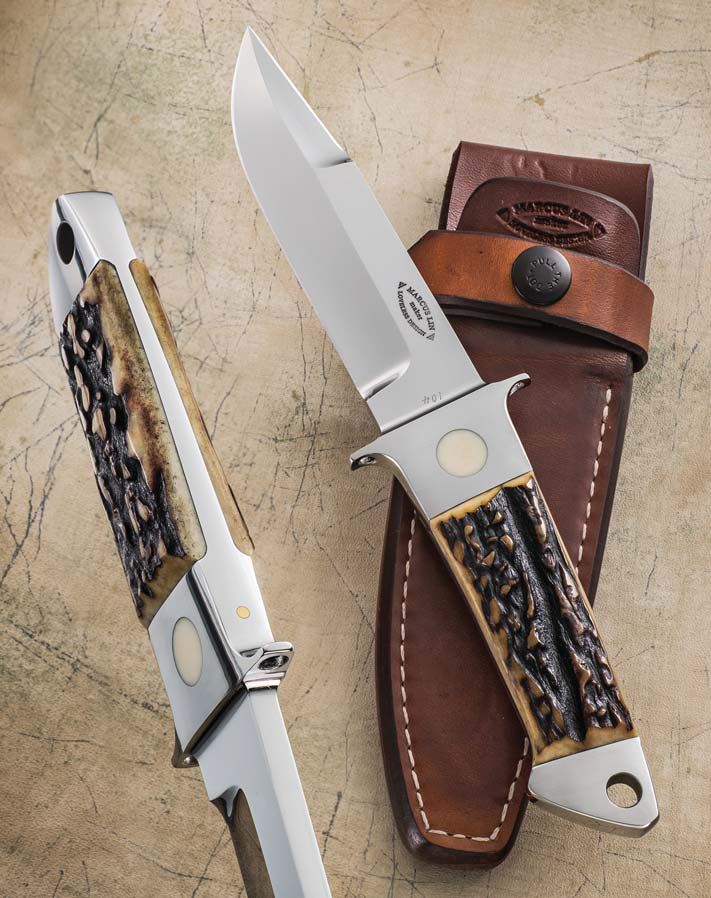

Are Integral Knives The Strongest Kind of Knife?
Is an integral knife inherently stronger? According to our gurus, strength in numbers—of parts, that is—is not necessarily applicable here.
“The concept is so much different it changes up the whole equation,” knifemaker Edmund Davidson states. “A hard-use integral knife is stronger than a typical fixed blade. There’s nothing to go wrong. That’s not to say some great [non-integral] fixed blades aren’t being made, but you can’t get any stronger than one big chunk of steel.”
“An integral knife is theoretically stronger, but I’ve never had one of my standard knives break at the guard junction through regular use, either,” knifemaker Marcus Lin says. “I destruction-tested one of my Loveless fighter designs several years ago and it took numerous overhead slams from a 50-pound slab of concrete to break it.
“In terms of getting the job done there’s no difference in either method of construction, as both will result in a knife that will last generations. But I can see the allure for the integral knife because of the time and additional skills involved in making it, which some customers can appreciate.”

What Is An Integral Knife?
Integral knives, short of the addition of handle scales, are literally sculpted from one piece of steel. Making a knife in this way presents difficult challenges not found in making knives in separate parts, and soldering or screwing them together.
Imagine grinding not only the blade with all its intricacies, but the handle, guard and pommel from one solid piece of steel and sculpting it to perfection. Such a knife is called an integral and any knifemaker who’s ever made one will tell you it’s a whole new ballgame.
How Integral Knives Are Made
“The primary difficulty for me is getting rid of the stock,” Lin relates. “You start out with a couple pounds of tool steel and the finished knife is several ounces. Bob [Loveless]‘s original integrals were made on his horizontal mill. I use a full-size Jet [Bridgeport clone] vertical milling machine, angle grinder, band saw and my 2×72 grinder to make mine. I try to make them as close as possible to Bob’s originals.”
Davidson makes no bones about the difficulty he faces in constructing a one-piece knife.

“It takes tenacity to build an integral,” Davidson stresses. “You start with a block of steel instead of a strip. You must have the equipment to saw the knife out and machine it. You’re working with all the basics that go into a complete knife in one single piece of steel. The complexities are physically and mentally demanding, and it’s very labor intensive because of the vast amounts of filing and sanding—not to mention hand rubbing the finish.
“There are so many aspects of making an integral that are not associated with making a standard knife.”
See More Incredible Knives at BLADE Show
Join us each June in Atlanta for the world’s largest and best knife show. Go to the BLADE Show website here.
 NEXT STEP: Download Your Free KNIFE GUIDE Issue of BLADE Magazine
NEXT STEP: Download Your Free KNIFE GUIDE Issue of BLADE Magazine
BLADE’s annual Knife Guide Issue features the newest knives and sharpeners, plus knife and axe reviews, knife sheaths, kit knives and a Knife Industry Directory.Get your FREE digital PDF instant download of the annual Knife Guide. No, really! We will email it to you right now when you subscribe to the BLADE email newsletter.








Hand ground or machined from stock, integrals are difficult, but the effort is minimized when they are drop forged. The CS Drop Forged series comes to mind, along with the AG Russel Sting, and some German knives which went a few years until the Chinese were contracted to make the base forging.
Like the AR, forging the basic shape has advantages in minimizing the shaping thru stock removal, as there is very little. It’s more finishing than shaping. It’s a very cost effective way to make an integral if the shape is cooperative and steel chosen to work with the method. 52100 is often used for bearing manufactured by forging and works well as a knife.
I’d like to see D2 used in a simple field knife pattern as a superior lower cost knife – it can be light if done well and stronger than casting, which is still being done but not described as the method in those knives.